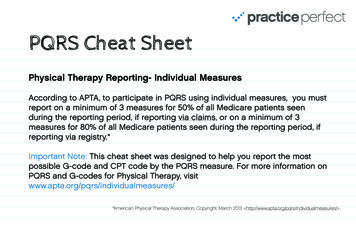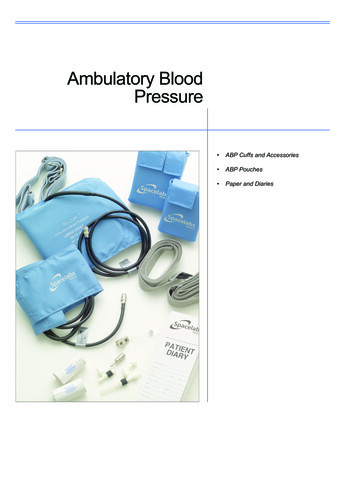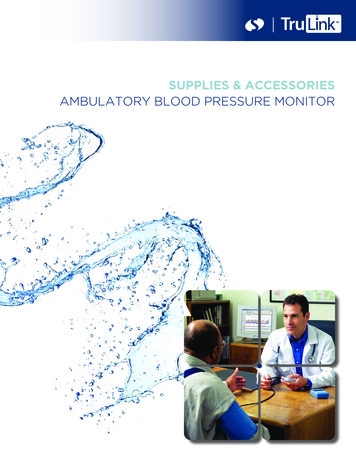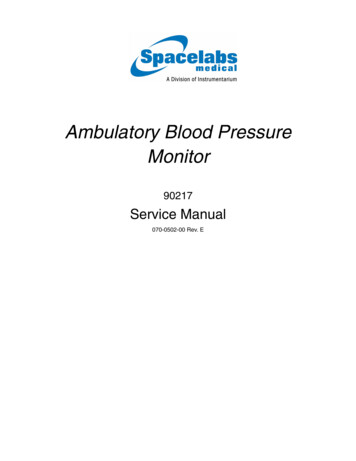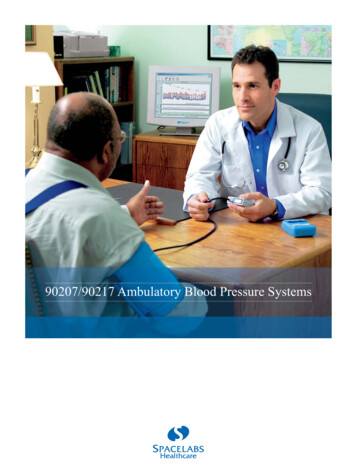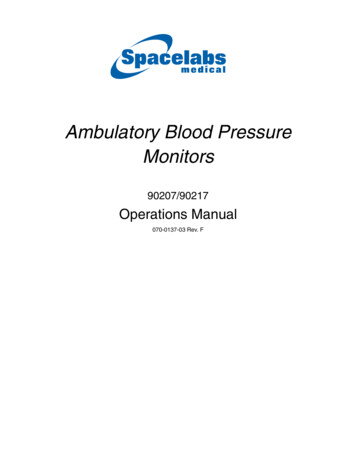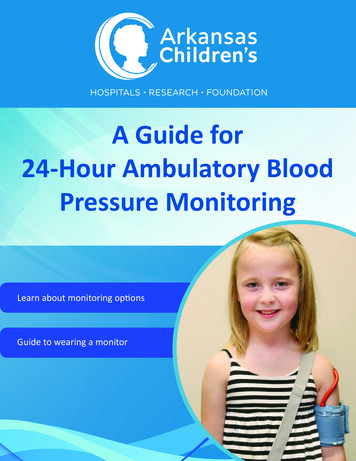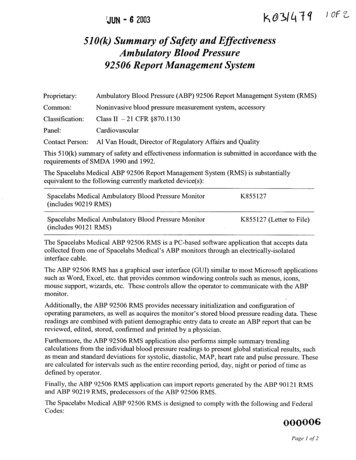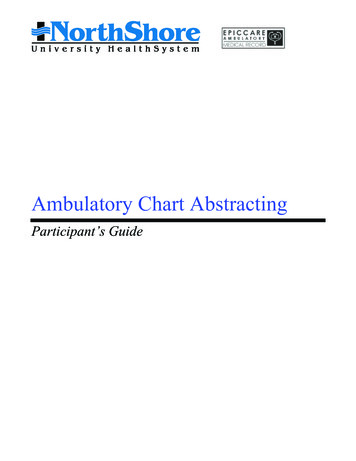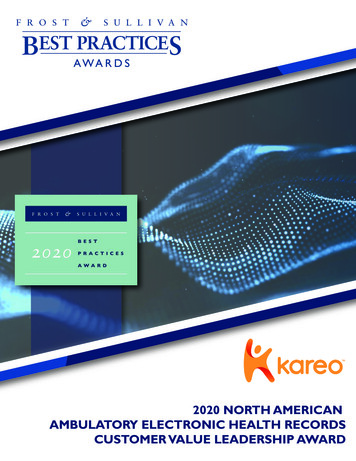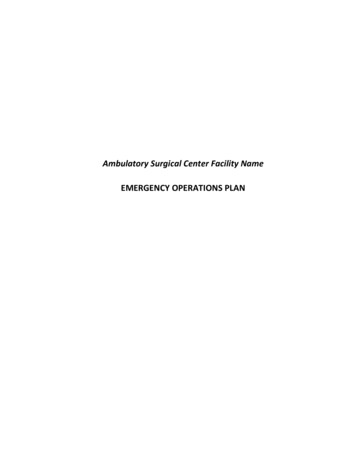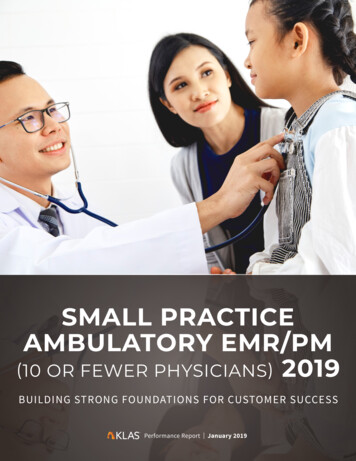
Transcription
SMALL PRACTICEAMBULATORY EMR/PM(10 OR FEWER PHYSICIANS) 2019BUILDING STRONG FOUNDATIONS FOR CUSTOMER SUCCESS%/ Performance Report January 2019
DRILL DEEPERTABLE OF CONTENTS2Executive Insights6Expanded Insights29Vendor alWorkseMDsGreenway HealthKareoNextGen HealthcareVirence Health (GE Healthcare)57Data Index68Vendor Executive Interview Details1
EXECUTIVEINSIGHTS
SMALL PRACTICE AMBULATORYEMR/PM (10 OR FEWER PHYSICIANS) 2019BUILDING STRONG FOUNDATIONS FOR CUSTOMER SUCCESSAs healthcare has moved beyond meaningful use, small practices have begun to expect more from their vendors and to look for EMRs that do morethan meet basic regulatory requirements. As a result, EMR/PM satisfaction among small practices (10 or fewer physicians) has varied greatly over thepast year—scores for a number of vendors have swung more than 10 percentage points (some positively, some negatively). To explore what the futureholds for this market, KLAS spoke to hundreds of small practice customers about their EMR/PM experiences and needs and also interviewed executivesand representatives from AdvancedMD, Allscripts, Aprima, athenahealth, Azalea Health, CareCloud, Cerner, CureMD, eMDs, Greenway Health, Kareo,NextGen, Quest Diagnostics, and Virence Health (GE Healthcare) to find out how these vendors plan to increase customer satisfaction going forward.NextGen Healthcare, CureMD, and AprimaMost Aligned to Deliver Customer SuccessWhat Are the Most Important Vendor/Product Attributes for Small Practices?(n 57)NeedsThe green bars representthe total tallies aftereach need was weightedbased on whether therespondent ranked it first,second, or third.New7AdvancedTechnologyWhen asked to name the top things EMR/PM vendors should focuson, small practices overwhelmingly say that before addressing moreTangibleadvanced issues, their vendors need to first figure out how to meetOutcomessmall practices’ needs for product functionality, product usability,and vendor support and guidance. NextGen Healthcare is thePrice/only vendor whose self-reported priorities align completely withValuethis desired focus, though responses from Aprima andCureMD also show alignment in many areas. This highSupport/Guidancealignment contributes to these three vendors’ havinghigher weighted overall satisfaction scores (weightedbased on small practices’ top priorities) and leadsEase of Use/Usabilitymany customers to view them less as technologysuppliers and more as partners who deliver astrong foundation for future client hich Vendors Are Most Aligned with Small Practices' Needs?Weighted Overall Performance Score (100-point scale) (n 243)100.0Limited sionalCureMDNextGen Healthcare OfficeCareCloud70.0AprimaKareoMarket AverageVirence HealthCPS (GE Healthcare)60.050.0Not StickyLess AlignedPromisersPerfectly Aligned40%Alignment between Small Practice Needs and Vendor-Reported Priorities(100-percent scale) (n 14)Note: Weighted overall performance scores are weighted based on the relative importance to small practicesof the following metrics (see chart above): product functionality, ease of use, support/guidance, price/value,tangible outcomes, and new technology.100%100Practices Want CareCloud,Cerner, and eMDs to Focuson the BasicsIn their interviews with KLAS, CareCloud, Cerner,and eMDs all emphasized that delivering newtechnology (bells and whistles) is their number onefocus. Such features can be beneficial once practices’basic needs for functionality, usability, and supportare met, but the fact that CareCloud, Cerner, andeMDs have lower customer satisfaction highlights amisalignment between what small practices need andwhat these vendors are focused on. Virence Health(formerly GE Healthcare) is relatively aligned to whatsmall practices need, and customers report cautiousoptimism under the new leadership. However,GE Healthcare had historically failed to deliver onpromises regarding improvements to CentricityPractice Solution, leading to low satisfaction.
AdvancedMD and Greenway Health QuicklyBecoming Top-Performing ContendersOver the past year, customer satisfaction with AdvancedMD and Greenway Health (Intergy customers only) has risen sharply, driven largely by positivechanges in support and relationships. AdvancedMD customers have noticed improvements in nearly every metric KLAS measures, reporting the biggestimprovements in money’s worth and training quality. Clients are especially pleased with the PM functionality, using terms such as “fantastic” and“streamlined,” and say the functionality has improved how their practices operate. While clients feel AdvancedMD still has room to improve, they havetaken notice of the vendor’s efforts to enhance the overall experience. Greenway Health has made an about-face recently, announcing that Intergy, notPrimeSuite, will be their go-forward platform. Intergy clients have taken note of efforts from Greenway Health to improve, reporting increased satisfactionwith the vendor’s support and client relationships as well as their implementations and training.Virence Health and Cerner See Significant DeclinesOver the past year, Virence Health (Centricity Practice Solution) and Cerner customers have reported the steepest declines in overall satisfaction, with thevendors’ scores falling 11 and 6 points, respectively. Though satisfaction with Virence Health has declined in all categories, customers report particulardissatisfaction with the vendor’s inability to keep promises, drive tangible outcomes, and deliver a product that isn’t buggy or missing functionality. Cernercustomers have seen declines in the support experience all around and have had poor experiences with implementations/upgrades, nickel-and-diming, andCerner’s training, which clients feel is not comprehensive enough to meet their needs.Year-Over-YearOverall Performance100.02017(100-point scale)Significant IncreaseIncreaseDecreaseDashed Line Limited DataNo Trend2018Aprima83.1 (n 29)Greenway Health Intergy81.4 (n 25)80.0AdvancedMD80.3 (n 25)athenahealth80.0 (n 30)NextGen Healthcare Office79.3 (n 20)CareCloud70.076.3 (n 20)eMDs74.7* (n 8)Kareo72.3 (n 22)Allscripts Professional72.1 (n 18)eClinicalWorks60.0CernerA AA-95–9891–9488–90B BB-C CC-85–8781–8478–8071.9 (n 23)70.4 (n 19)Virence Health CPS(GE Healthcare) 67.8 (n 21)D 65–67D 61–64D- 58–6075–7771–7468–70Culture84.6 (n 28)CureMD90.0Category PerformanceF dMD(n 25)B-B C BCB-Allscripts Professional(n 18)CC-B-B-CDAprima(n 28)A-B B BBBathenahealth(n 30)C B C BC-BCareCloud(n 20)CB-CB-DB-Cerner(n 19)DC D CDCCureMD(n 29)BBBB-BB eClinicalWorks(n 23)D CB-C CD Greenway Health Intergy(n 25)B-BBBB C Kareo(n 22)CCB-CFCNextGen Healthcare Office(n 20)C B CB-D BVirence Health(n 21)C-C-C CD D-(n 8)C C B-CC C-CPS (GE Healthcare)Limited Data50.0*Limited dataeMDsMore Investment in Training Needed for Better Provider Success REPORTS 2019This material is copyrighted. Any organization gaining unauthorized access to this report will be liable tocompensate KLAS for the full retail price. Please see the KLAS DATA USE POLICY for information regardinguse of this report. 2019 KLAS Enterprises, LLC. All Rights Reserved.Net EMR Experience Score—By Quality of Initial TrainingQuality of initial training measured by agreement that initial training provided strong preparation.Physicians and advanced practice providers only.Market AverageStrongly agree (n 2,860)Agree (n 13,161)nce63.4Diff-Point11.7Indifferent (n 6,742)ere43.1Disagree (n 6,640)-4.7Strongly disagree (n 3,551)(Scale of -100.0 to 100.0)88.2Feedback from more than 32,000 physicians and advanced practiceproviders (collected through KLAS’ Arch Collaborative initiative) showsthat training is one of the leading predictors of future EHR successand satisfaction. This indicates that not all user dissatisfaction withEMR/PM solutions can be attributed to the solution itself. Vendorsinterviewed for this small practice report echo this finding, with 6 ofthe interviewed 14 saying that they feel customers underinvest ineducation. One vendor executive shared, “I think what customers dois underinvest in education as the product evolves. . . . They want toimplement it . . . and move on.” This lack of continual EHR learning has adirect and adverse effect on providers’ ability to document effectivelyand often leads to dissatisfaction with the EHR as well as the vendor.-100.0-24.80.0100.0
REPORT INFORMATIONReader ResponsibilityKLAS data and reports are a compilation of research gathered from websites, healthcareindustry reports, interviews with healthcare organization executives and managers, andinterviews with vendor and consultant organizations. Data gathered from these sourcesincludes strong opinions (which should not be interpreted as actual facts) reflecting theemotion of exceptional success and, at times, failure. The information is intended solely as acatalyst for a more meaningful and effective investigation on your organization’s part and is notintended, nor should it be used, to replace your organization’s due diligence.KLAS data and reports represent the combined opinions of actual people from healthcareorganizations regarding how their vendors, products, and/or services perform against theirorganization’s objectives and expectations. KLAS findings are a unique compilation of candidopinions and are real measurements representing the feedback of interviewed individuals. Thefindings presented are not meant to be conclusive data for an entire client base. Significantvariables—including a respondent’s role within their organization as well as the organization’stype (rural, teaching, specialty, etc.), size, objectives, depth/breadth of software use, softwareversion, and system infrastructure/network—impact participants’ opinions and preclude anexact apples-to-apples vendor/product comparison or a finely tuned statistical analysis.We encourage our clients, friends, and partners using KLAS research data to take into accountthese variables as they include KLAS data with their own due diligence. For frequently askedquestions about KLAS methodology, please refer to the KLAS FAQs.AuthorAaron Gleaveaaron.gleave@KLASresearch.comAuthorAlex ht InfringementWarningThis report and its contents are copyright-protectedworks and are intended solely for your organization.Any other organization, consultant, investmentcompany, or vendor enabling or obtainingunauthorized access to this report will be liable forall damages associated with copyright infringement,which may include the full price of the report and/orattorney fees. For information regarding your specificobligations, please refer to the KLAS Data Use Policy.NoteThe findings presented are not meant to beconclusive data for an entire client base. Performancescores may change significantly when additionalhealthcare organizations are interviewed, especiallywhen the existing sample size is smaller, as in anemerging market with a small number of live clients.DesignerNatalie Jamisonnatalie.jamison@KLASresearch.comProject ManagerKelly Coxkelly.cox@KLASresearch.com630 E. Technology Ave.Orem, UT 84097Ph: (800) 920-4109Our MissionImproving the world’s healthcare throughcollaboration, insights, and transparency.Project ManagerStorie Smithstorie.smith@KLASresearch.comFor more information aboutKLAS, please visit our website:www.KLASresearch.comCover image: 1981 Rustic Studio kan/Shutterstock.com
EXPANDEDINSIGHTS
E X PA N D E D I N S I G H T SABOUT THIS REPORTEach year, KLAS interviews thousands of healthcare professionals about the products and servicestheir organizations use. These interviews are conducted using a standard quantitative evaluation,and the scores and commentary collected are shared online in real time so that other providers andIT professionals can benefit from their peers’ experiences.To supplement the data gathered with this standard evaluation, KLAS also creates varioussupplemental evaluations that target a subset of KLAS’ overall sampling and delve deeper into themost pressing questions facing healthcare technology today.The data in this report comes from both evaluation types and was collected over the last 12 months.The number of unique responding organizations who provided standard evaluations is givenin the chart below. Supplemental evaluations were collected from a total of 57 unique providerorganizations (including customers of each vendor listed below), but no vendor-specific informationfrom these evaluations is shared in the report, so specific evaluation counts are not included below.Figure 1StandardEvaluationsVendor ExecutiveInterviewEstimatedCustomer oderateeClinicalWorks22Declined to ParticipateExtensiveeMDs8YesModerateGreenway Health Intergy24YesModerateKareo17YesExtensiveNextGen Healthcare Office20YesModerate20YesExtensiveAzalea Health0YesSmallQuest Diagnostics 6YesSmallVirence Health (GE Healthcare)Centricity Practice SolutionOther Validated VendorsNote: Some organizations may have rated more than one product.7
E X PA N D E D I N S I G H T SWhat Does the Asterisk Mean?Some products are used in only a small number of facilities, some vendors are resistant toproviding client lists, and some respondents choose not to answer particular questions. Thus avendor’s sample size for any one question may not reach KLAS’ required threshold of 15 uniquerespondents. When a vendor’s sample size for a particular question is less than 15, the score forthat question is marked with an asterisk (*) or otherwise designated as Limited Data. If the samplesize is less than 6, no score is shown. Note that when a vendor has a low number of reporting sites,the possibility exists for KLAS scores to change significantly as new surveys are collected.Overall scores are measured on a 100-point scale and represent the weighted average of severalyes/no questions as well as other questions scored on a 9-point scale.OVERALL, AMBULATORY EMR/PM SOLUTIONS NOT MEETINGSMALL PRACTICES’ EXPECTATIONSOver the past 12 months, there have been large swings in EMR/PM satisfaction among smallambulatory practices (10 or fewer physicians). While some of this change has been positive,many practices feel their EMR/PM vendor is out of step with their needs and should be placingmore emphasis on delivering solutions that help small practices meet their full potential—on thebusiness and financial side as well as the clinical side. This misalignment with small practices’needs has led to lower overall market performance (the Small Practice Ambulatory EMR/PMmarket is in the 28th percentile compared to all markets KLAS measures), and no vendors exceedcustomer expectations.To discover what needs are most important to small practices and how aligned vendors are withthese needs, KLAS interviewed customers of 14 of the largest EMR/PM solutions targeted to smallpractices and also invited vendor executives to share how their companies plan to meet smallpractices’ needs. Representatives from AdvancedMD, Allscripts, Aprima, athenahealth, AzaleaHealth, CareCloud, Cerner, CureMD, eMDs, Greenway Health, Kareo, NextGen Healthcare, QuestDiagnostics, and Virence Health (formerly GE Healthcare) all shared with KLAS their plans for thefuture, what factors they believe are most impacting customer satisfaction, and the areas they arecurrently focusing on to better meet clients’ needs. eClinicalWorks declined to participate.While previous KLAS reports on small ambulatory practices included a wide variety of solutions,this report focuses on the vendors who provide both an EMR and a PM solution for familypractice settings.8
E X PA N D E D I N S I G H T SBASIC NEEDS (FUNCTIONALITY, USABILITY, AND SUPPORT)MOST IMPORTANT TO SMALL PRACTICESKLAS asked healthcare professionals at small practices to list the top three most importantpriorities they feel their EMR/PM vendors should be focused on. The most common responseswere that, before providing more advanced capabilities, vendors need to first master the basicbuilding blocks of functionality, usability, and vendor support and guidance. A practice managerexplained, “The most important attribute is product functionality because we need the product todo what it is supposed to do. That is what the doctors live off of every day, so the options and thefunctionality have to be there for the doctors to carry on with their day. The next most importantthing is the ease of use because physicians want the system to be easy. They want fewer clicks. Thethird most important attribute is customer service because we run across a lot of questions, and Ineed somebody to help me answer them in a timely manner.”What Are the Most Important Vendor/ProductAttributes for Small Practices?(n 57)dNeedsThe green bars represent the totaltallies after each need was weightedbased on whether the respondentranked it first, second, or /Value46Support/Guidance69Ease of Use/Usability80sedNeicBasFigure 2ProductFunctionality940100Only 5% of respondents chose new technology as their top priority, and only two respondentschose it as their second or third priority. 88% of respondents feel their vendor needs to focuselsewhere first. A practice manager stated, “Because we are a small practice, we are always priceconscious. We don’t have unlimited resources to keep buying technology. Technology helps us do ourjobs a little better, but it does not generate revenue. . . . In the ever-changing software world, we needto have issues fixed, and we need to have updated functionality.”Vendor priorities stand in stark contrast. 75% report new technology as one of their top threepriorities, with 25% identifying it as their number one focus.9
E X PA N D E D I N S I G H T SWhat Do Small Practices Feel They Are Missing from TheirEMR/PM Solution?Regardless of which EMR/PM solution they use, many respondents share the same opinionson where EMR/PM vendors should focus their efforts. Interoperability/integration, reporting,general fixes to standard functionality, billing capabilities, and support/communication are thetop things small practices would like to see improved. “We are missing interoperability with allvendors,” reported a physician. “We need to be able to communicate with other physicians who useother systems. There is a push to get that done. But the idea has been out there for a long time, andnothing has happened. We need to be able to completely send our medical records with no issues.Right now, we receive faxes from a dozen different x-ray facilities, and then we have to scan them inand manually match them with the patients. That is a big waste of time. When a patient goes to anER somewhere else, I want to get that report without having to call somebody to fax the report in.Interoperability is definitely the next critical thing.”Figure 3What Is the One Piece of Technology/Functionality/Service That YouWish Your EMR/PM Vendor Could Offer but is Currently Missing?Better Billing Functionality"Other" includes care coordination, document management, searchable medical history with patient codes, and telemedicine.10
E X PA N D E D I N S I G H T STHE VENDORS’ VIEWPOINTAs part of this research, KLAS interviewed representatives from AdvancedMD, Allscripts, Aprima,athenahealth, Azalea Health, CareCloud, Cerner, CureMD, eMDs, Greenway Health, Kareo,NextGen Healthcare, Quest Diagnostics, and Virence Health (GE Healthcare). The purpose ofthese interviews was to Determine how aligned vendors’ visions and priorities are with small practices’ needsGain vendor perspectiv
This lack of continual EHR learning has a direct and adverse effect on providers’ ability to document effectively and often leads to dissatisfaction with the EHR as well as the vendor. Net EMR Experience Score—By Quality of Initial Training Year-Over-Year Overall Performance Aprima 83.1
